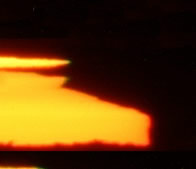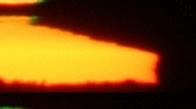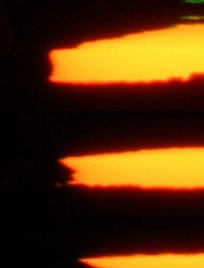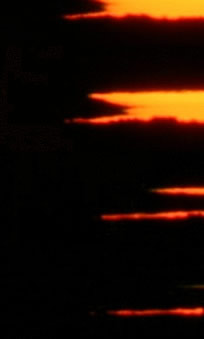|
Mock mirage sunset & green flash seen from the ESO
La Silla Observatory, Chile  altitude
2400m by
astronomer Jesús Maíz Apellániz (site).
M-Mir flashes are always below the astronomical
horizon - the altitude helped increase the dip of the
actual horizon and the space available for the mirage.
Image ©Jesús
Maíz Apellániz altitude
2400m by
astronomer Jesús Maíz Apellániz (site).
M-Mir flashes are always below the astronomical
horizon - the altitude helped increase the dip of the
actual horizon and the space available for the mirage.
Image ©Jesús
Maíz Apellániz |
| |
As the sun sinks it transforms into fantastical shapes. Sometimes
an onion dome, sometimes a rectangle, sometimes stacked pancakes.
A piece breaks off the top and for a second or so shines green.
This is another form of green flash, a mock
mirage, M-Mir, flash.
The M-Mir flash is produced by an atmospheric temperature inversion.
Ordinarily the air temperature decreases
monotonically with increasing height. An inversion is the presence
of a kink in the temperature profile whereby layers exist that
are warmer than usual.
An increase in temperature of only one or two degrees Celsius
can produce distorted sunsets and green flashes.
You must be above the inversion layer to see a pure M-Mir flash.
Inversion layers can, however, be quite close to ground or ocean.
Sometimes atmospheric waves cause the inversion layer
to undulate and then a variant
of the M-Mir flash is visible from below it.
|
|
|
|








